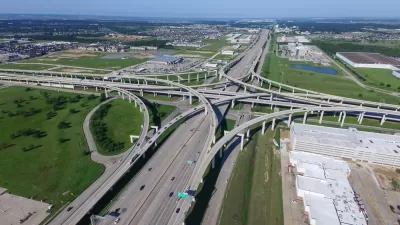CityLab University tackles a widely misunderstood concept: induced demand.

CityLab University endeavors to provide clear explanations of some of the "most important concepts related to cities and urban policy." A previous post explained inclusionary zoning, for instance. For the most recent post, Benjamin Schneider explains the concept of induced demand, or why new road capacity doesn't reduce traffic.
Launching the explanation with the example of the Katy Freeway in Houston, which has 26 lanes at its widest point, and still sees worsening congestion.
The idea that the Katy Freeway could expand to such capacity and still see regular congestion is explained by induced demand. While Schneider goes into a lot more detail in the source article, here are the key points that organize the article:
- In urbanism, “induced demand” refers to the idea that increasing roadway capacity encourages more people to drive, thus failing to improve congestion.
- Since the concept was introduced in the 1960s, numerous academic studies have demonstrated the existence of ID.
- But some economists argue that the effects of ID are overstated, or outweighed by the benefits of greater automobility.
- Few federal, state, and local departments of transportation are thought to adequately account for ID in their long-term planning.
FULL STORY: CityLab University: Induced Demand

Planetizen Federal Action Tracker
A weekly monitor of how Trump’s orders and actions are impacting planners and planning in America.

San Francisco's School District Spent $105M To Build Affordable Housing for Teachers — And That's Just the Beginning
SFUSD joins a growing list of school districts using their land holdings to address housing affordability challenges faced by their own employees.

The Tiny, Adorable $7,000 Car Turning Japan Onto EVs
The single seat Mibot charges from a regular plug as quickly as an iPad, and is about half the price of an average EV.

Seattle's Plan for Adopting Driverless Cars
Equity, safety, accessibility and affordability are front of mind as the city prepares for robotaxis and other autonomous vehicles.

As Trump Phases Out FEMA, Is It Time to Flee the Floodplains?
With less federal funding available for disaster relief efforts, the need to relocate at-risk communities is more urgent than ever.

With Protected Lanes, 460% More People Commute by Bike
For those needing more ammo, more data proving what we already knew is here.
Urban Design for Planners 1: Software Tools
This six-course series explores essential urban design concepts using open source software and equips planners with the tools they need to participate fully in the urban design process.
Planning for Universal Design
Learn the tools for implementing Universal Design in planning regulations.
Smith Gee Studio
City of Charlotte
City of Camden Redevelopment Agency
City of Astoria
Transportation Research & Education Center (TREC) at Portland State University
US High Speed Rail Association
City of Camden Redevelopment Agency
Municipality of Princeton (NJ)





























